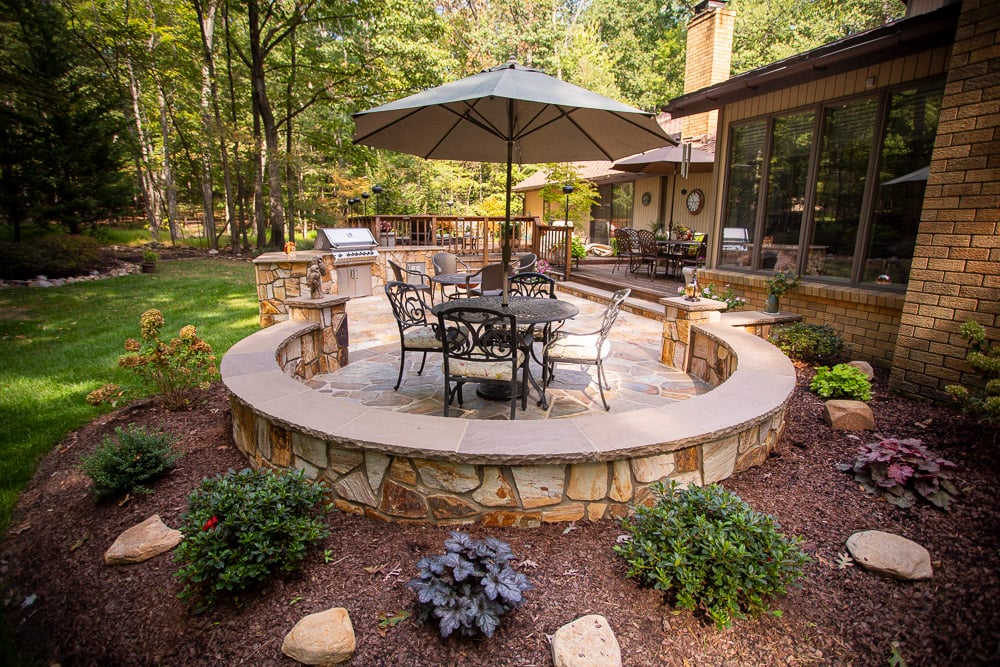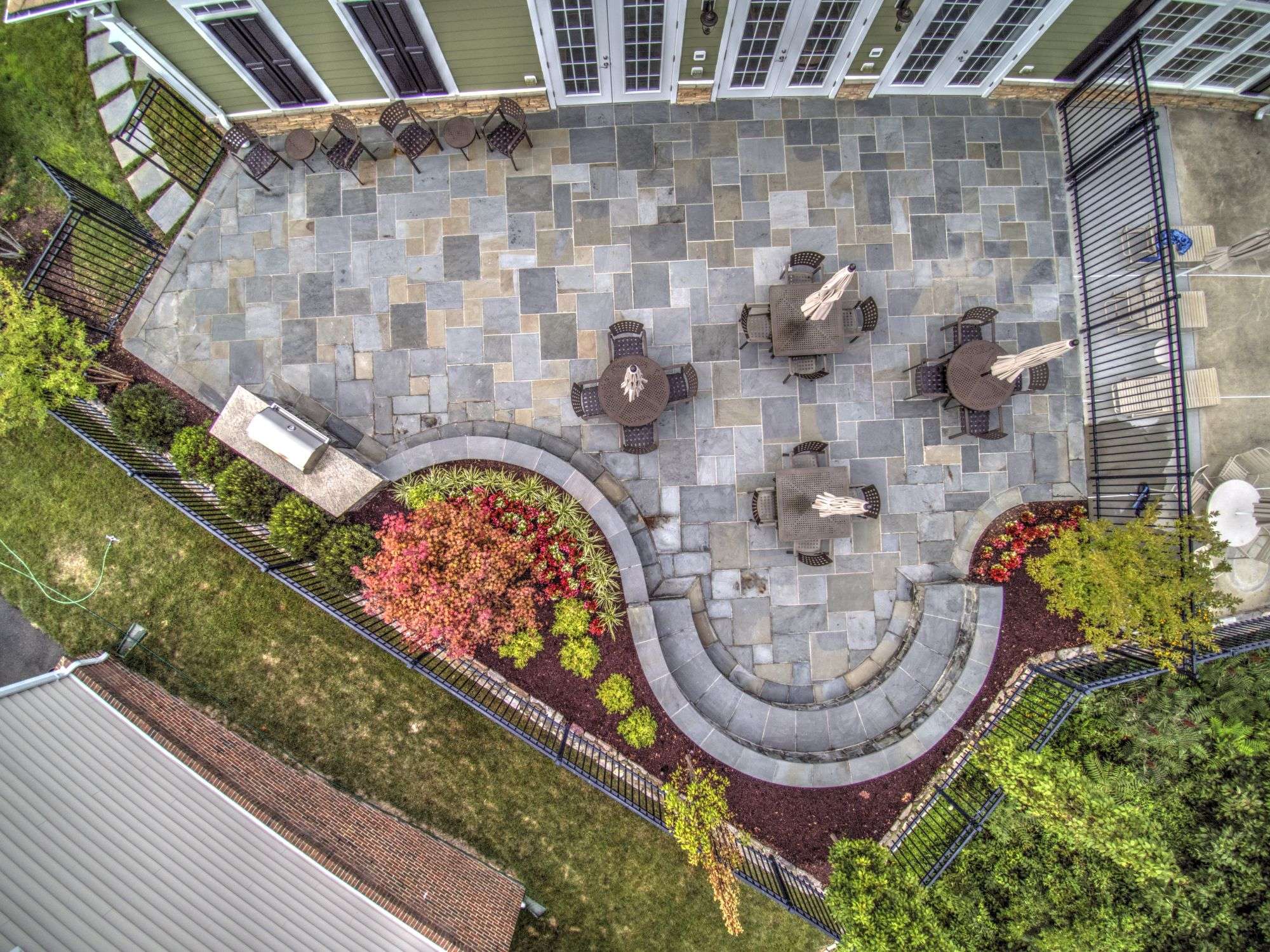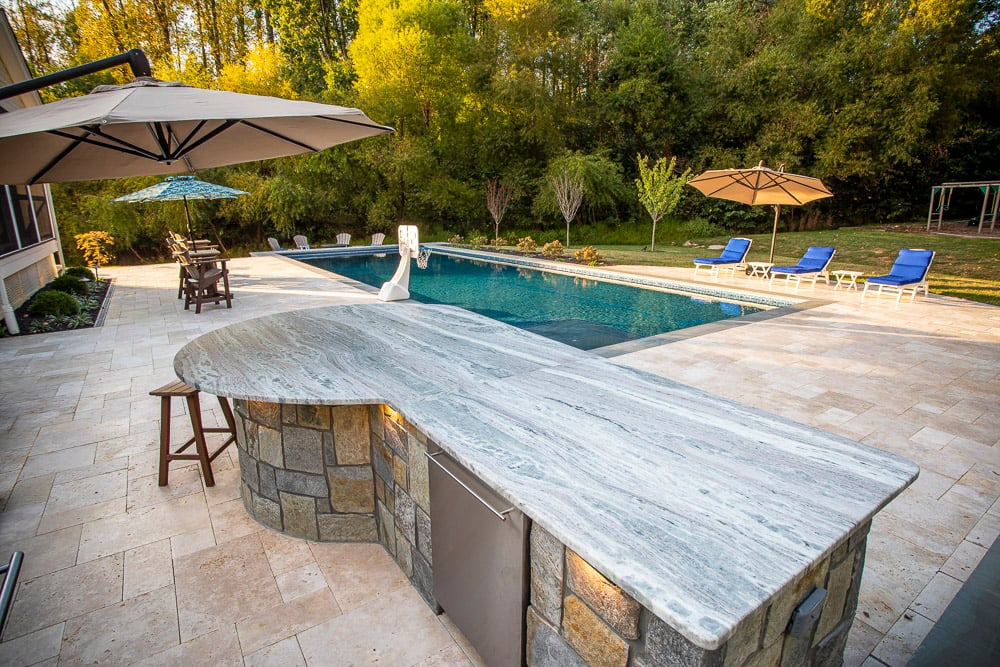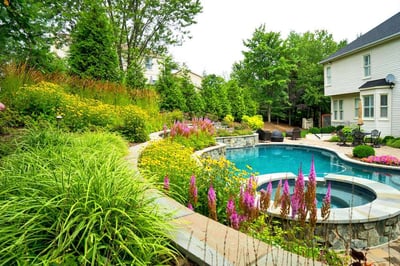 Nothing quite says “backyard escape” like a pool. Chances are when you picture your dream pool, you likely imagine a backyard oasis. What makes that possible is not only the pool itself but the landscaping around your pool. Landscaping the pool area can completely transform the space into the retreat you’ve always wanted.
Nothing quite says “backyard escape” like a pool. Chances are when you picture your dream pool, you likely imagine a backyard oasis. What makes that possible is not only the pool itself but the landscaping around your pool. Landscaping the pool area can completely transform the space into the retreat you’ve always wanted.
While the right landscape design poolside can make a big splash, the wrong choices can have just the opposite effect. Instead of enjoying your pool retreat you might be spending extra time cleaning up the high-maintenance or messy trees and shrubs that you chose. Or maybe you’re feeling exposed to all of the neighbors’ prying eyes since you didn’t choose the best privacy screening plants.
Whatever the case may be, you don’t want to be left with a sinking feeling that you chose poorly.
That’s why we’ve rounded up some of these helpful landscape design pool ideas to help you make the best choices possible.
Pool Area Landscaping Ideas to Consider
Choosing the right plantings around your pool can have several key benefits that will go a long way in creating the perfect pool area.
Create an Area with Beautiful Blooms
Considering the fact that you’re going to be spending a lot of time around your pool in the summer months, it adds to the aesthetic appeal to have trees and shrubs that are in bloom while you spend time in the pool area.
Of course, there is a lot of variation when it comes to blooming time. Some plants may only bloom once while others will re-bloom. The timing of the bloom is important as you want to create visual interest from May through late September (or maybe even later if you have a pool heater or hot tub, or if you use your pool patio throughout the Fall).
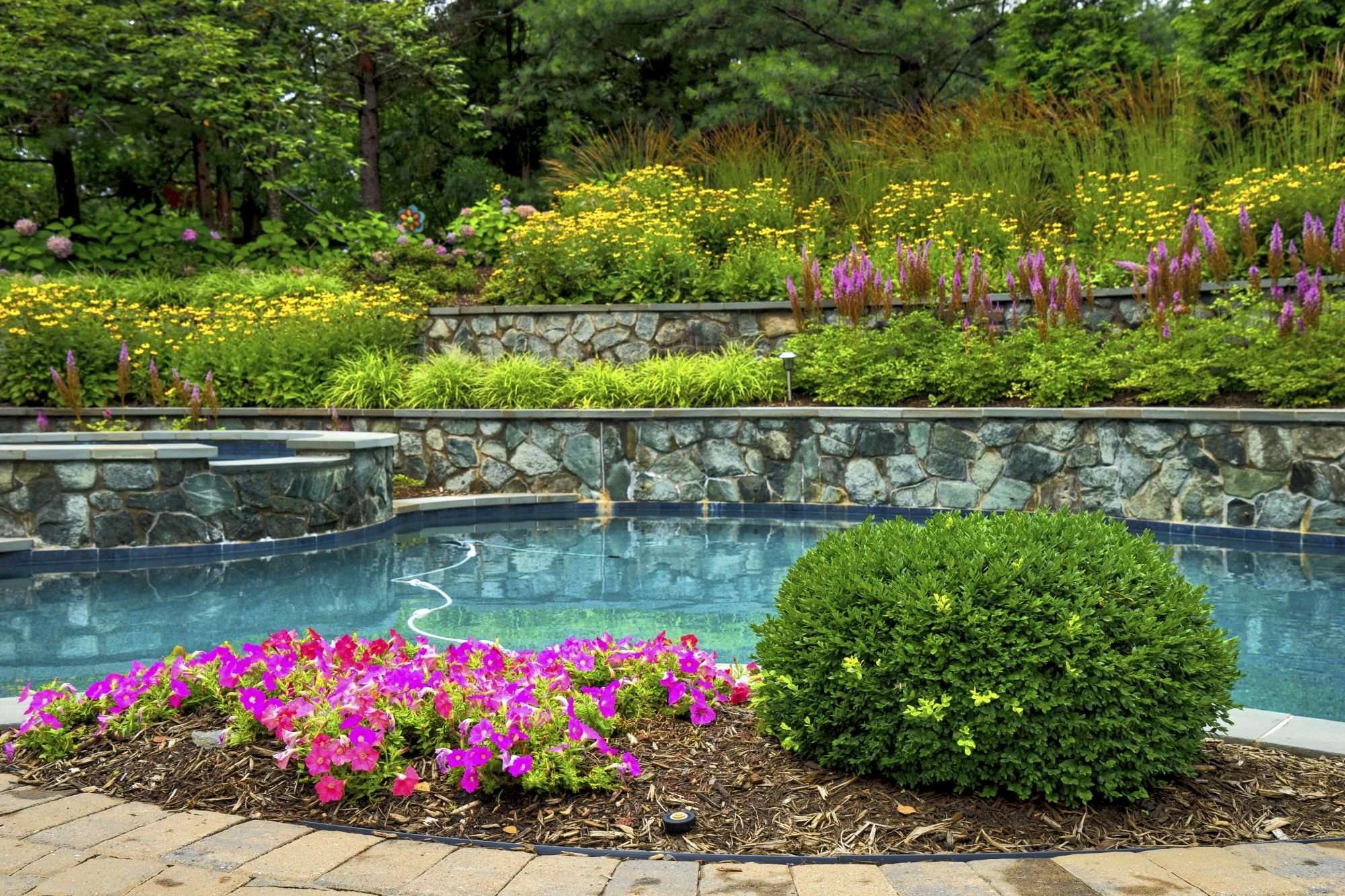
Placement of blooming plants is also important. You don’t want one area to bloom at one part of the season, then another at a different part of the season. Instead, a good designer will think about how to evenly and purposefully choose plants for all areas so there is always a degree of blooming happening throughout.
Small ornamentals that produce summertime blooms are a great choice, assuming you get the placement right. If you place blooming trees too close to the pool, or in the path of the wind, then you are going to wind up with petals all over your patio or floating in your water. But when strategically placed near the pool, the following trees, shrubs, and perennials would make a lovely addition to a pool area.
Shrubs to Consider
- Hydrangea: These flowering shrubs produce beautiful blooms in colors like pink, purple, and blue.
- Viburnum: These shrubs produce either white or pink fragrant blooms in early spring.
- Roses: With its exquisite blooms, a rose bush is incredibly appealing but you must be careful about its placement due to thorns. We use rose bushes as “interior plants” meaning there are other plants around it so that you would never be right up against the thorns.
Trees to Consider
- Dogwood varieties: Dogwood tree varieties are early spring bloomers and provide large fragrant blooms in a variety of colors.
- Styrax: Also called the Japanese Snowbell, this compact deciduous flowering ornamental tree has bell-like white flowers, as its common name implies.
- Vitex: Commonly called a Chaste tree, this tree has a long blooming season from late spring through early fall. It produces long, upright spikes of pink, purple, and white flowers.
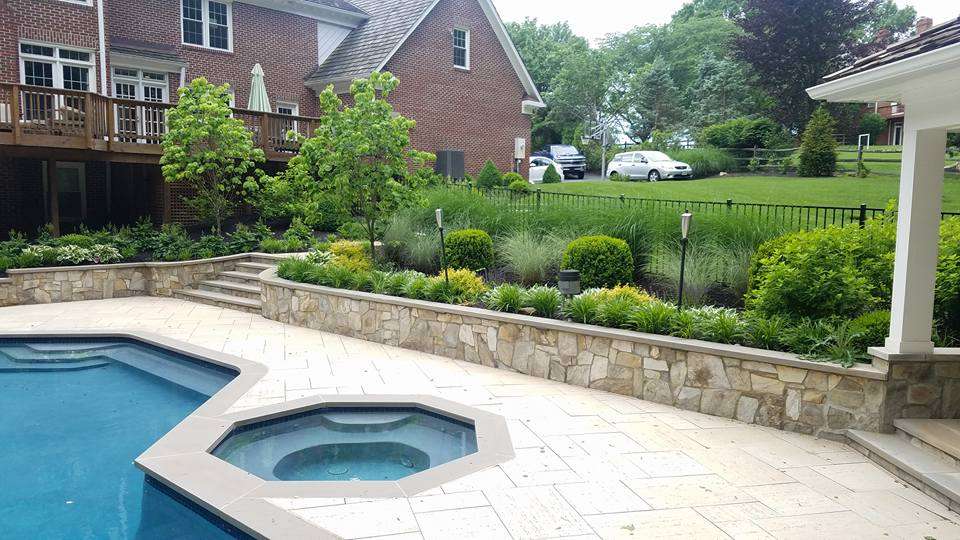
Perennials to Consider
- Astilbe: This perennial has fern-like foliage in bright colors like red, purple, and pink.
- Black-eyed Susan: This North American flowering plant is part of the sunflower family and produces blooms in a variety of colors.
- Purple Coneflower: This perennial has a showy bloom but is very low-maintenance.
- Shasta Daisy: This cheerful flower is a classic perennial with all-white petals, a yellow middle, and dark green leaves.
- Catmint: With rich purple blooms that grow in vertical spikes, catmint is an easy-to-grow and attractive perennial to add to your pool area.
- Hosta: These perennials, known for their big leaves, produce summer flowers with spiked blooms that resemble lilies. They tend to attract hummingbirds.
Of course, certain blooming trees are just too much for a pool area. A cherry tree, for instance, might look pretty but all of the falling fruit and petals are just too much for a pool area.
Ultimately, it comes down to finding a nice middle ground. You want blooms, but you don’t want a mess. A landscape designer can help lead you toward a selection of trees and shrubs that will give you the best of both worlds and place those plants in areas where they won’t cause problems but will give you the maximum benefit.
Using Trees and Shrubs for Privacy Screening
When landscaping a pool area, chances are, you want to think about privacy. After all, you don’t want to feel as though all of your neighbors are watching every time you and your family step out in your swimsuits and try to enjoy some family time. You ought to be able to enjoy your pool area with only the people using it (friends and family)—not the whole neighborhood.
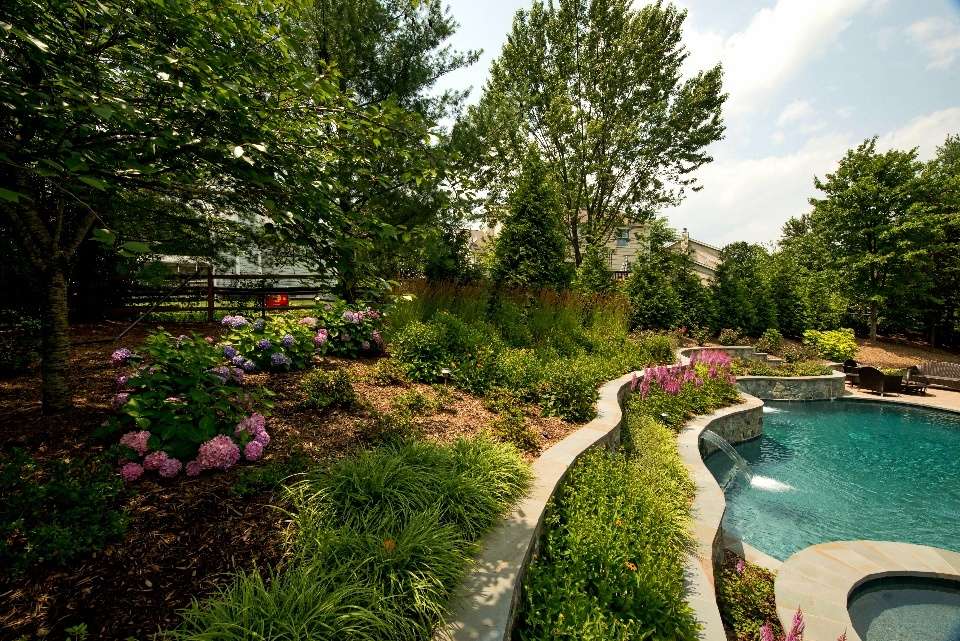
Trees and shrubs can play a huge role in creating privacy screening around your pool—assuming that you make wise choices. While you might be inclined to think that the height of the trees or shrubs you choose is the key factor in how well they will provide screening, the truth is that placement is even more critical.
A landscape designer should give strategic thought to exactly where the trees and shrubs are placed. Sometimes that may even mean placing trees and shrubs outside of the pool area (closer to the neighbors or outside of the pool fence) where they will best block prying eyes.
As you think about your landscape design poolside, here are some plants that can help you to create a privacy screen.
Shrubs to Consider
- Bayberry: When used as a hedge, the evergreen bayberry shrub can help form a privacy screen thanks to its dense foliage.
- Gracillimus: Ornamental grasses, such as the gracillimus species, can create privacy. Remember that when you are in the pool, you are much lower. Therefore even shorter shrubs can offer privacy screening when dense enough.
- Viburnum: This shrub has fragrant flowers and can grow tall and wide enough to offer privacy screening.
Trees to Consider
- Green Giant Arborvitae: This fast-growing evergreen is known to grow as much as 3 feet per year and can make a very effective privacy screen.
- Emily Brunner Holly: This dense holly takes a pyramid-like shape as it grows. Due to its dense nature, it provides some nice screening abilities.
- Hornbeam: This narrow tree can help form a privacy wall when located near other hornbeam trees.
- Cryptomeria: This large evergreen of the cypress family can be very effective at providing some privacy screening.
Staggering your Trees and Shrubs
One of the biggest mistakes we see made when it comes to the overall aesthetics of a pool landscape is the fact that people tend to put them all in a row. This is commonly done as a means of creating a privacy screen but it doesn’t look naturally appealing to the eye. After all, trees and shrubs do not grow in a straight line in nature.
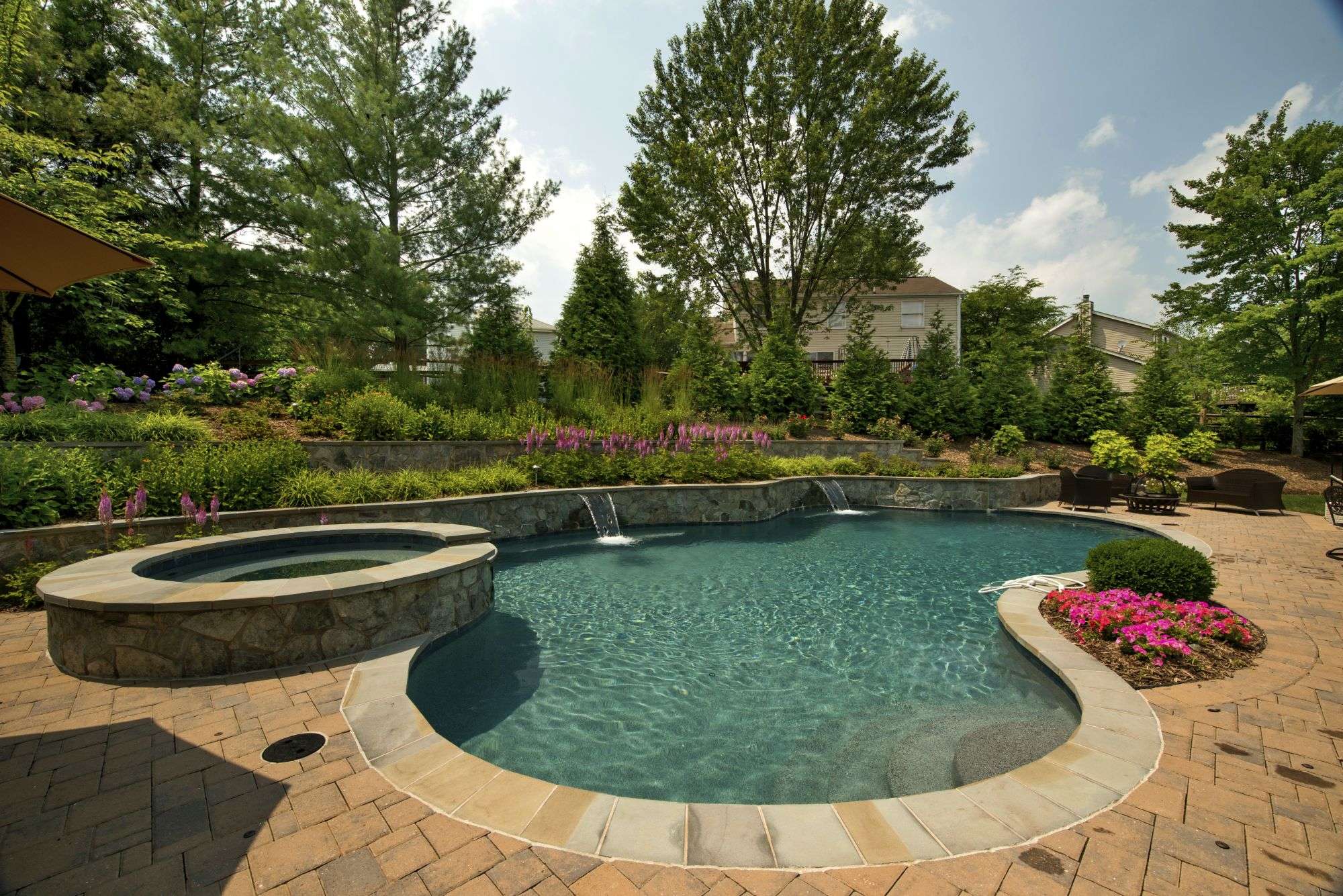
With strategic placement, you can have both privacy and aesthetic appeal by staggering your trees. A landscape designer will know how to do this in a way that gives you the best of both worlds.
Staggering your trees and shrubs can also help you create a quicker screen than planting in a single-file row. The gaps that are left when trees are all lined up in a straight row are more “filled in” with a staggered row. This creates a visual block much sooner.
Tread Cautiously with these Landscape Design Pool Ideas
Of course, it’s not just what you do in your pool area that counts. It’s also what you don’t do. By making an unwise choice with the types of plants you choose for your pool area, you could negatively impact the entire space. You must be careful about the selections you make.
Consider some of these following ideas with caution.
Be Strategic if Using Plants with Thorns
Trees or shrubs that have thorns must be used as “interior plantings” in a pool landscape design. As mentioned, we like to use rose bushes around a pool area, but they are used as interior plants. For instance, this might mean using a row of roses that are “blocked” to touch (not visually) by a row of boxwoods. By containing a thorny rose bush as an interior planting, you get to enjoy its beauty without being worried about the thorns.
Certain holly trees and shrubs can also be prickly and should not be extremely close to the pool area. Some locust trees also have thorny fallen branches that should be kept away from the pool.
Keep Messy Trees or Shrubs at a Distance
As mentioned, certain trees, such as the cherry tree, have the ability to create a mess in your pool area. Any trees that have messy blooms that will land in the pool or berries that can fall onto your patio and get crushed (causing stains), should be strategically placed, particularly downwind from prevailing summertime winds.
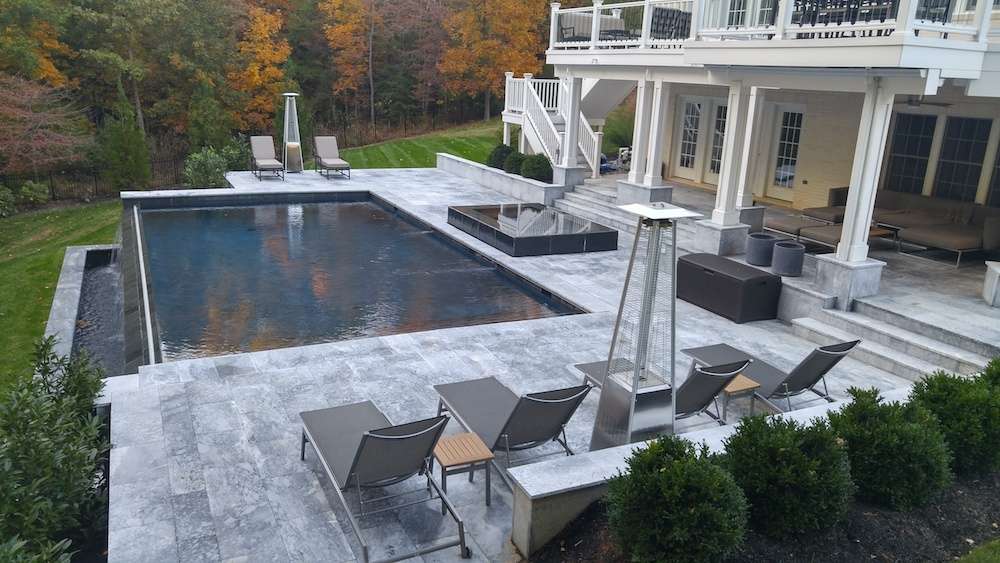
In addition, while a Crepe Myrtle is a beautiful tree that looks nice in a landscape with a pool if this tree is used, it’s important that strategic thought is given to the placement of this tree. That’s because it drops petals that can have an unpleasant odor. A landscape designer would know to place a tree like this in an area where it can be seen and enjoyed from the pool but where it won’t be dropping petals all over the patio.
Other messy trees include needle-bearing evergreens and large deciduous trees, which are going to drop a lot of leaves.
It’s not that these trees cannot be used at all. Oftentimes we will install a crepe myrtle as part of a new poolscape. But where it is placed is key. Those swimming and lounging in the pool area can enjoy the beauty of a crepe myrtle even if it’s placed at a safe distance where its petals will not wind up on the patio. It all comes down to a smart landscape design for the pool.
Don’t Select Trees with Invasive Roots
Trees with aggressive root systems have the possibility to do a lot of damage. The last thing that you want is to plant a tree close to your pool area and have the roots ultimately grow underneath the patio and start lifting it up. Aggressive roots can also grow toward pool plumbing and wiring and begin to cause complications.
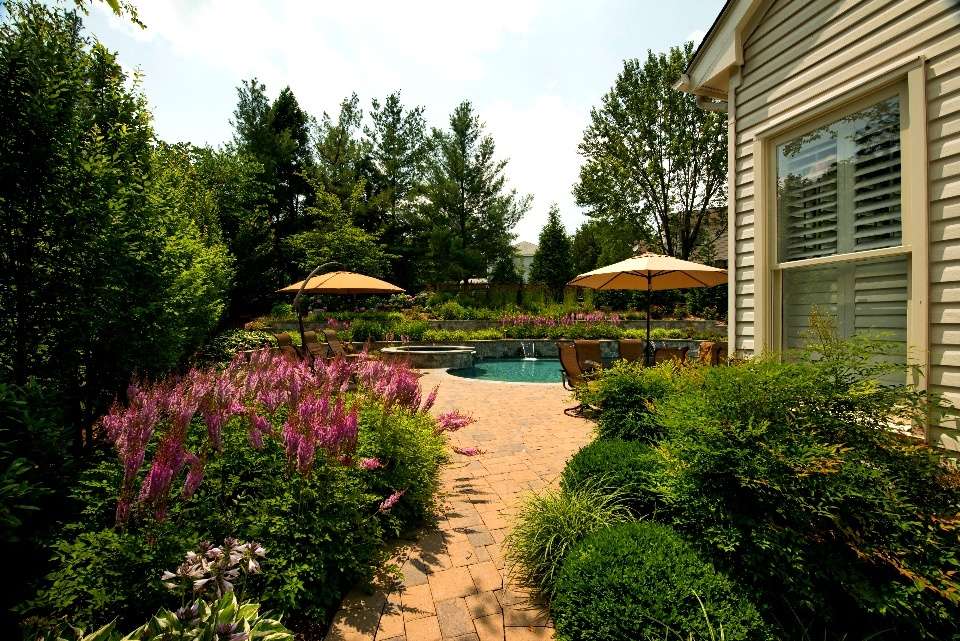
The trouble is, without the assistance of a landscape designer, you might not consider the future growth of the tree. But you must always be thinking about the future of your pool area.
Trees to avoid nearby a pool, include some of the following, which are known to have very invasive root systems.
- Willow
- Maple
- Cherry
- Elm
Avoid Plants that are High Maintenance
Your choices for your pool landscape design should also be plants that are easy to maintain. After all, you want your backyard pool to be a sort of retreat. The last thing that you want is to have hours and hours of maintenance involved because you’ve chosen plants that require a lot of care.
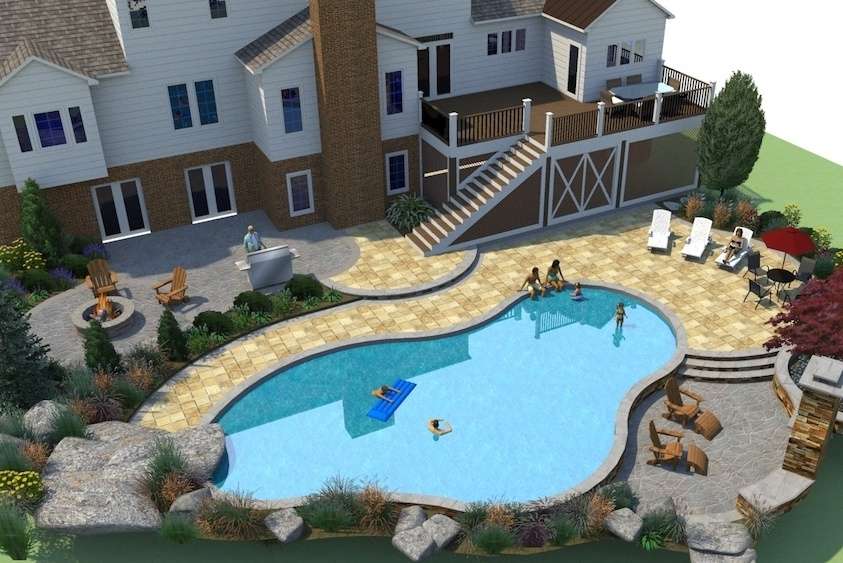
It’s also important to note that even low maintenance plants require at least some care, which still may be more than you want to do. Services such as pruning or plant bed maintenance can be handed off to a professional who will ensure they’re done right. This will help keep your plants in the best possible shape so that all you have left to do is enjoy them while swimming or lounging poolside.
Making the Best Landscape Design Choices for Your Pool
Knowing which plants to use in your landscape pool design isn’t easy without a lot of background knowledge of trees and shrubs. That’s why working with an experienced landscape designer will help you to make wise choices from the very start.
You might have certain trees and shrubs that you love but that may not be the ideal choice for a pool area. A landscape designer might be able to direct you to a slightly different alternative that’s a great choice for a pool area. A designer will have a good eye for design as well as knowledge and experience of working with a wide variety of plant material.
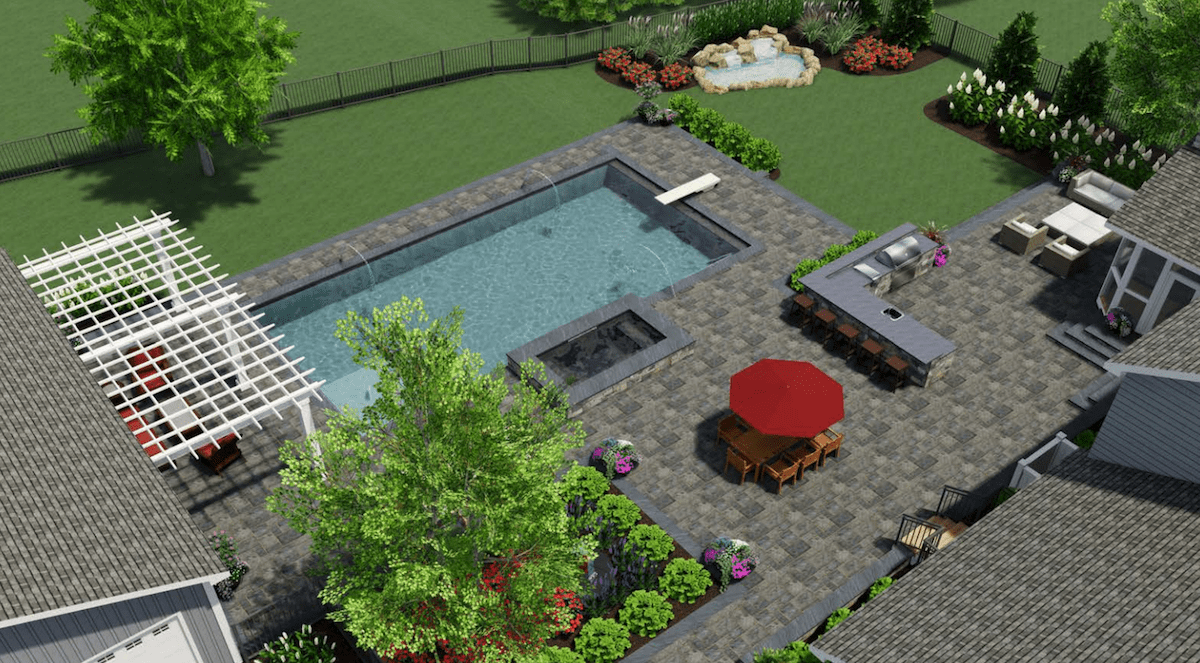
Instead of worrying that the plant material you’ve chosen will negatively impact your poolscape, you’ll feel confident that you have the very best variety and selection of plants for your backyard retreat. That means that all you’ll have left to do is enjoy your beautiful space.
If you want to choose the best plants for your brand-new or existing pool at your Ashburn, Aldie, or Leesburg, VA home, talk to an expert, choose a solution that rocks, and then get the full enjoyment out of your backyard escape.



%20Facebook%202025-03-17%20at%201.11.44%20PM.jpg)
